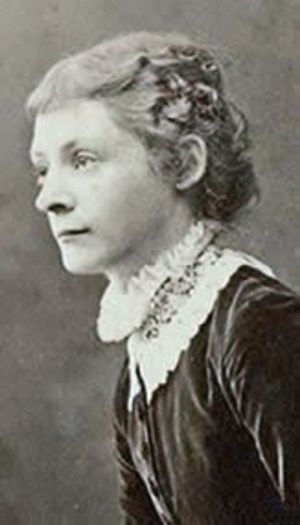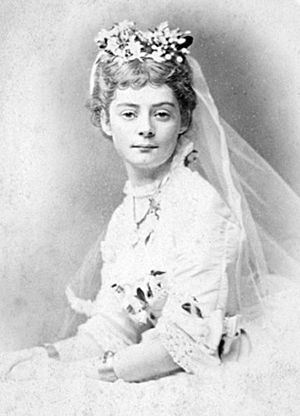Ellis Rowan facts for kids
Marian Ellis Rowan (born 30 July 1848, died 4 October 1922), known as Ellis Rowan, was a famous Australian artist. She was best known for drawing plants, especially flowers. She also created many pictures of birds, butterflies, and other insects.
Contents
Life Story
Marian was born at "Killeen" near Longwood, Victoria, Australia. This was one of her father's large farms where animals were raised. Her family was quite well-known.
She went to a private school in Melbourne. In 1873, she married Captain Charles Rowan. He was interested in botany, which is the study of plants. He encouraged Ellis to paint wild flowers.
Ellis Rowan had no formal art training. However, she worked very carefully using water-colours. Her paintings are known for being both beautiful and helpful for identifying plants.
In 1877, Rowan returned to Melbourne. For many years, she traveled around Australia, painting the country's unique plants. Sometimes, she painted with her friend, Margaret Forrest.
Ellis Rowan showed her art at the 1893 World's Columbian Exposition in Chicago, USA. In 1898, she published a book called A Flower-Hunter in Queensland and New Zealand. This book was based on letters she wrote to her husband and friends.
Around this time, she traveled to North America. She drew pictures for several books about wild flowers and trees by Alice Lounsberry. While in America, Ellis received sad news that her son, Eric, had passed away in Africa.
In 1905, she had a very successful art show in London. She then returned to Australia and held more exhibitions. Her paintings sold for high prices. In 1916, she made her first trip to New Guinea. She went there several times and drew many pictures. She caught malaria during these trips.
In 1920, Ellis Rowan held her biggest art show ever in Australia. She displayed 1000 of her artworks in Sydney. She passed away in Macedon, Victoria. Her husband had died in 1892 from pneumonia. Her only son had also passed away earlier.
The Australian Club in Melbourne has a room with walls completely covered in murals painted by Ellis Rowan. She was asked to create these special paintings for the club.
Even though she won many gold medals, some people did not fully appreciate her art. This was because she was a woman. For many years, her art was kept in the National Library, not the National Gallery.
Ellis Rowan's Art Collection
National Library of Australia Collection
In 1923, after Ellis Rowan passed away, her family offered her collection of 952 paintings to the Australian government. After some discussion, the government bought the paintings for 5000 pounds.
The collection was kept safely in vaults until 1933. Then, it was moved to the Commonwealth National Library. Today, 919 of her paintings are kept at the National Library of Australia.
Queensland Museum Collection
The Queensland Museum also has a collection of 125 botanical paintings by Ellis Rowan. These paintings have been available for people to see for many years. Her collection was moved to the Queensland Museum in 1912 after a successful exhibition.
How Ellis Rowan Painted
Painting Techniques
Ellis Rowan often painted her Queensland pictures indoors. She would work late into the night, drawing plants she had collected during the day. However, she was also a fast painter who created many botanical paintings outdoors. These outdoor paintings usually did not have a pencil sketch underneath.
Ellis painted and traveled because she was curious and loved nature. She didn't plan to be a strict scientific botanical illustrator. She once wrote about her Queensland paintings: "The collection is painted with a view of showing the general public how the flowers grow with their surroundings—while they are all botanically correct you cannot in the one drawing make a picture of the flower and also show it scientifically drawn in sections which is quite a different study."
Ellis wanted to create beautiful art. She often drew bold, close-up pictures of flowers. Her colourful and lively plants were shown in their natural homes, often extending beyond the edge of the picture. She sometimes added insects and even snakes to her artworks. This was to make the pictures more exciting and dramatic.
Ellis said she taught herself how to paint. She used traditional watercolour methods along with thicker, opaque paints to show details. She also made several copies of her paintings.
Plants in Her Art
For today's plant scientists, Ellis Rowan's paintings have limited scientific value. This is because they don't always have all the tiny details needed for scientific plant drawings. However, her drawings are accurate enough to help people identify most of the plants she drew.
Even though Ellis said she didn't know much about plants, she loved discovering the plant world. She dried many plant samples for her own collections.
Early in her career, artists often drew just one flower or branch. But later, Ellis started to show plants in their natural environment. She created her own plant world rather than just drawing every detail she saw. Sometimes, Ellis even created "new species" plants. She would combine parts of different plants, and these combinations often looked very pleasing.
Ellis also had her own favourite types of plants to paint. She preferred colourful and showy flowers, like waterlilies, which were her most loved. She didn't often paint plants with many small flowers, like the large sunflower family.
Animals in Her Art
Besides her amazing plant paintings, Ellis Rowan was also good at drawing animals and insects. Her series of New Guinea bird and butterfly drawings are a big part of her animal art.
About one-third of Ellis's paintings in the Queensland Museum show many kinds of animals. These include beetles, butterflies, snakes, and dragonflies. These insects or animals were probably added to her plant paintings later. This is because Ellis often finished her paintings indoors.
It's thought that Ellis might have combined plants and insects freely, without always thinking about their real-life connection. Her interest in animals came from her family. Her niece, Lady Casey, remembered that Ellis enjoyed seeing how different parts of nature came together.
Ellis Rowan was very excited about her art. This helped her to observe the insect world and animal life closely. These creatures brought her joy and helped her relax from her busy plant painting. Besides observing insects, Ellis also collected them. Her letters often mentioned her collecting adventures, including stories about snakes.
She had sheets of paper in her studio covered with rows of butterflies. This shows she studied them to add to her flower paintings. However, adding these animals and insects was more for artistic effect than for scientific accuracy. Even though the scientific value of Ellis's plant paintings is limited, they are wonderful historical records of Queensland's plants. They show the work of an artist who loved beauty and artistic expression.
Royal Worcester
Ellis Rowan was asked to create a series of paintings. These were used as designs on Royal Worcester tea sets. A collection of this special porcelain is kept at the National Trust of Australia property, Saumarez Homestead. The original drawings are at the Museum of Royal Worcester.
Awards Won by Ellis Rowan
Ellis Rowan won many awards and medals for her art at big exhibitions around the world, including:
- International Exhibition Melbourne, 1873
- Sydney International Exhibition, 1879
- International Colonial and Export Exhibition, Amsterdam, 1883
- Colonial and Indian Exhibition, London, 1886
- World Columbian Exposition, 1892-1893
Memorials
Portrait
A portrait of Ellis Rowan by Sir John Longstaff was unveiled in 1929. People donated money to pay for it. It was the first national portrait of an Australian woman.
Rowan Street
A street in the Canberra suburb of Cook is named after her.
Ellis Rowan Building
The first building in the Australian National Botanic Gardens was named in her honour.
See also
- List of Australian botanical illustrators
Images for kids
-
Flame azalea by Ellis Rowan, from Southern Wildflowers and Trees by Alice Lounsberry
-
Rothschild's Bird of Paradise Astrapia rothschildi, Papua New Guinea c. 1917.







